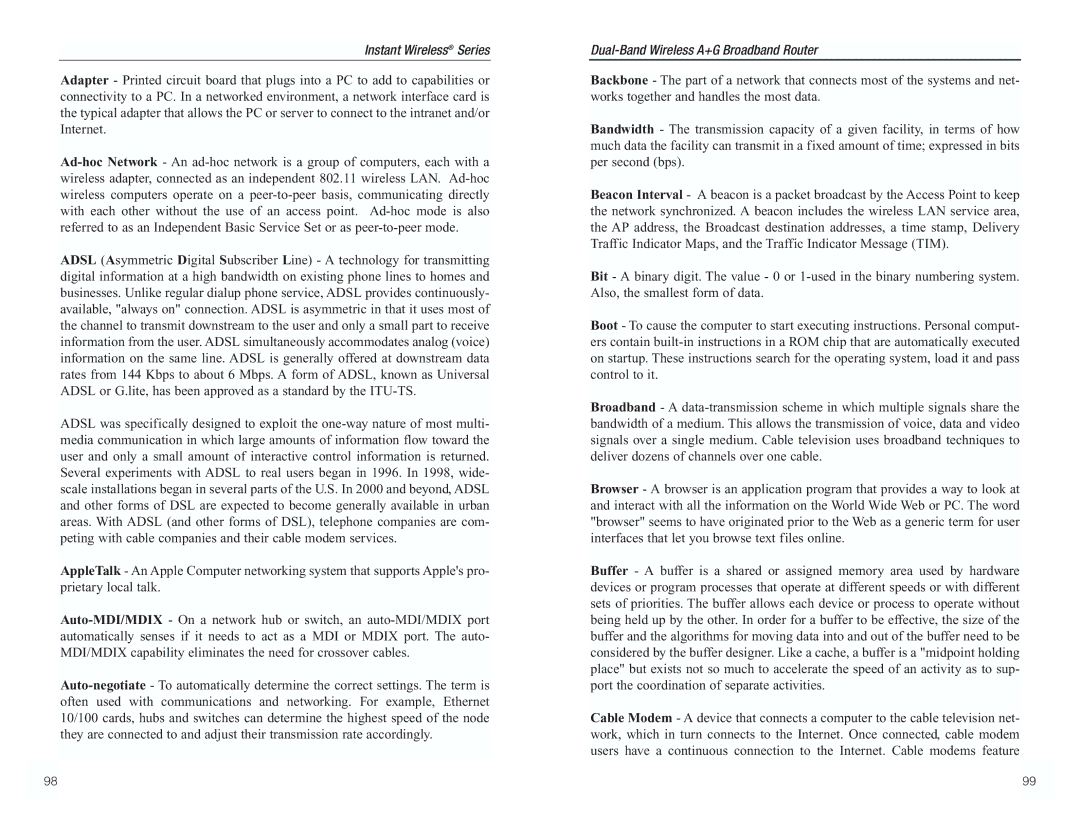Instant Wireless® Series
Adapter - Printed circuit board that plugs into a PC to add to capabilities or connectivity to a PC. In a networked environment, a network interface card is the typical adapter that allows the PC or server to connect to the intranet and/or Internet.
Ad-hoc Network - An ad-hoc network is a group of computers, each with a wireless adapter, connected as an independent 802.11 wireless LAN. Ad-hoc wireless computers operate on a peer-to-peer basis, communicating directly with each other without the use of an access point. Ad-hoc mode is also referred to as an Independent Basic Service Set or as peer-to-peer mode.
ADSL (Asymmetric Digital Subscriber Line) - A technology for transmitting digital information at a high bandwidth on existing phone lines to homes and businesses. Unlike regular dialup phone service, ADSL provides continuously- available, "always on" connection. ADSL is asymmetric in that it uses most of the channel to transmit downstream to the user and only a small part to receive information from the user. ADSL simultaneously accommodates analog (voice) information on the same line. ADSL is generally offered at downstream data rates from 144 Kbps to about 6 Mbps. A form of ADSL, known as Universal ADSL or G.lite, has been approved as a standard by the ITU-TS.
ADSL was specifically designed to exploit the one-way nature of most multi- media communication in which large amounts of information flow toward the user and only a small amount of interactive control information is returned. Several experiments with ADSL to real users began in 1996. In 1998, wide- scale installations began in several parts of the U.S. In 2000 and beyond, ADSL and other forms of DSL are expected to become generally available in urban areas. With ADSL (and other forms of DSL), telephone companies are com- peting with cable companies and their cable modem services.
AppleTalk - An Apple Computer networking system that supports Apple's pro- prietary local talk.
Auto-MDI/MDIX- On a network hub or switch, an auto-MDI/MDIX port automatically senses if it needs to act as a MDI or MDIX port. The auto- MDI/MDIX capability eliminates the need for crossover cables.
Auto-negotiate- To automatically determine the correct settings. The term is often used with communications and networking. For example, Ethernet 10/100 cards, hubs and switches can determine the highest speed of the node they are connected to and adjust their transmission rate accordingly.
Dual-Band Wireless A+G Broadband Router
Backbone - The part of a network that connects most of the systems and net- works together and handles the most data.
Bandwidth - The transmission capacity of a given facility, in terms of how much data the facility can transmit in a fixed amount of time; expressed in bits per second (bps).
Beacon Interval - A beacon is a packet broadcast by the Access Point to keep the network synchronized. A beacon includes the wireless LAN service area, the AP address, the Broadcast destination addresses, a time stamp, Delivery Traffic Indicator Maps, and the Traffic Indicator Message (TIM).
Bit - A binary digit. The value - 0 or 1-used in the binary numbering system. Also, the smallest form of data.
Boot - To cause the computer to start executing instructions. Personal comput- ers contain built-in instructions in a ROM chip that are automatically executed on startup. These instructions search for the operating system, load it and pass control to it.
Broadband - A data-transmission scheme in which multiple signals share the bandwidth of a medium. This allows the transmission of voice, data and video signals over a single medium. Cable television uses broadband techniques to deliver dozens of channels over one cable.
Browser - A browser is an application program that provides a way to look at and interact with all the information on the World Wide Web or PC. The word "browser" seems to have originated prior to the Web as a generic term for user interfaces that let you browse text files online.
Buffer - A buffer is a shared or assigned memory area used by hardware devices or program processes that operate at different speeds or with different sets of priorities. The buffer allows each device or process to operate without being held up by the other. In order for a buffer to be effective, the size of the buffer and the algorithms for moving data into and out of the buffer need to be considered by the buffer designer. Like a cache, a buffer is a "midpoint holding place" but exists not so much to accelerate the speed of an activity as to sup- port the coordination of separate activities.
Cable Modem - A device that connects a computer to the cable television net- work, which in turn connects to the Internet. Once connected, cable modem users have a continuous connection to the Internet. Cable modems feature

